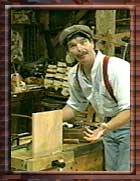I grew up watching This Old House with my dad. We’d watch Norm Abram (way back before he was a Master Carpenter) make an old wreck of a home look beautiful. One of the constants of the show was that the homes were always a frenzy of activity. Dozens of people were always framing, plumbing, roofing and finishing. The tools were amazing – I still remember seeing Norm’s laser-guided mitre saw for the first time. Houses were rebuilt to spectacular size and style, and an endless parade of specialists put their stamp on individual aspects of the home. A big, multi-team crew took a home with a lot of potential and turned it into something great.
 After years of following This Old House, we stumbled across The Woodwright’s Shop (on a lower rent public television station). If you’ve never seen it, you need to go watch a few episodes now. Roy Underhill blew my mind. We had found the complete opposite of This Old House. Gone were the specialists, fancy tools, commercial plugs and ostentatious facades. Roy Underhill took tools that would have been old in 1750 and turned out some of the most beautiful woodwork I had ever seen. He’d cut down his own trees. He powered his lathe with his foot. Sometimes, during the show, he would make the tool he needed then turn around and use it – all in a single shot.
After years of following This Old House, we stumbled across The Woodwright’s Shop (on a lower rent public television station). If you’ve never seen it, you need to go watch a few episodes now. Roy Underhill blew my mind. We had found the complete opposite of This Old House. Gone were the specialists, fancy tools, commercial plugs and ostentatious facades. Roy Underhill took tools that would have been old in 1750 and turned out some of the most beautiful woodwork I had ever seen. He’d cut down his own trees. He powered his lathe with his foot. Sometimes, during the show, he would make the tool he needed then turn around and use it – all in a single shot.
He did sometimes bring in experts. I remember the guy he brought in who built a violin with a pocket knife and a hand saw. But he wasn’t there to build a violin for Roy, he was there to teach Roy how to do it.
He didn’t use any tricks. He didn’t use anything your grandfather (or his neighbor) didn’t have in his garage.
But he did something Bob Vila and Norm Abram (whom I still think is fantastic) never did. He made himself personally responsible for the entire process start to finish. Nobody else could take the blame if the table turned out crooked or the door didn’t close correctly. A mistake was never due to a problem with a tool, because the tools were never expected to be smart enough to control themselves.
It was all Roy, his sweat, and the practice in his hands.
The difference between the two shows and the two approaches is exactly the difference between traditional publishing and indie publishing. Both showcased a ton of skill. Both could produce beautiful results. Both had a great market for what they built. And either would fully respect the quality of the other’s work. The difference was never about quality.
The difference was about reliance on experts vs. development of expertise.
Experts vs. expertise are both completely reasonable approaches. It’s not even about picking Norm’s way or Roy’s way. It’s about understanding the implications of a Norm approach or a Roy approach at each stage of your work.
Where do you want to do the hard work to develop expertise? Make no mistake, Roy always sweated more than Norm. Where do you want to allow yourself to specialize, and what are you willing to trade for that? How much are you willing to trust someone else’s expertise? Roy couldn’t build a brick wall as well or as fast as they did on This Old House.
So, are you a Norm or a Roy?
